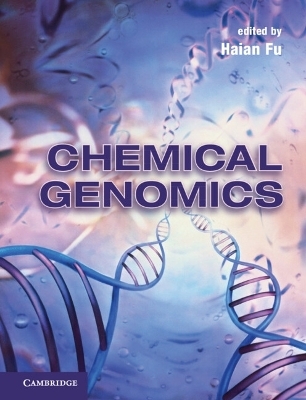
Chemical Genomics
Cambridge University Press (Verlag)
978-0-521-88948-3 (ISBN)
Advances in chemistry, biology and genomics coupled with laboratory automation and computational technologies have led to the rapid emergence of the multidisciplinary field of chemical genomics. This edited text, with contributions from experts in the field, discusses the new techniques and applications that help further the study of chemical genomics. The beginning chapters provide an overview of the basic principles of chemical biology and chemical genomics. This is followed by a technical section that describes the sources of small-molecule chemicals; the basics of high-throughput screening technologies; and various bioassays for biochemical-, cellular- and organism-based screens. The final chapters connect the chemical genomics field with personalized medicine and the druggable genome for future discovery of new therapeutics. This book will be valuable to researchers, professionals and graduate students in many fields, including biology, biomedicine and chemistry.
Haian Fu is a Professor of Pathology, Hematology, and Medical Oncology at Emory University School of Medicine. He also serves as director of the Chemical Biology Discovery Center and co-director of the Discovery and Developmental Therapeutics Program at the Winship Cancer Institute at Emory University. His research focuses on protein-protein interactions in signal transduction pathways that control cell survival and death in normal and cancer cells. He serves on the editorial board of several scientific journals, including Current Chemical Genomics. He edited Protein-Protein Interactions: Methods and Applications (2004). Dr Fu has been recognized by various honors including the PhRMA Faculty Development Award, the Burroughs Wellcome Fund New Investigator Award, the GRA Distinguished Investigator Award and the Georgia Cancer Coalition Distinguished Cancer Scholar. He is also a recipient of the Award for Excellence in Mentorship by the Emory Graduate Division of Biological and Biomedical Sciences (2000) and the Emory Pharmacology Teaching Excellence Award (2006).
Part I. Overviews: 1. Harnessing the power of chemistry for biology and medicine Cheryl L. Meyerkord and Haian Fu; 2. Chemical genomics: exploring biology with small organic molecules Nicholas Aberle and Craig M. Crews; 3. Chemical proteomics Akihisa Matsuyama, Yoko Yashiroda and Minoru Yoshida; Part II. Molecules for Chemical Genomics: 4. Diversity-oriented synthesis Warren R. J. D. Galloway, Richard J. Spandl, Andreas Bender, Gemma L. Thomas, Monica Diaz-Gavilan, Kieron M. G. O'Connell and David R. Spring; 5. Targeted chemical libraries Gregory P. Tochtrop and Ryan E. Looper; 6. Fragment-based ligand discovery Sandra Bartoli, Antonella Squarcia and Daniela Fattori; 7. Basics and principles for building natural product-based libraries for HTS Ronald J. Quinn; Part III. Basics of High Throughput Screening: 8. Essentials for high throughput screening operations Stewart P. Rudnicki, James V. Follen, Nicola J. Tolliday and Caroline E. Shamu; 9. High content analysis and screening: basics, instrumentation and applications Paul A. Johnston; 10. Phenotypic screens with model organisms Grant N. Wheeler, Robert A. Field and Matthew L. Tomlinson; 11. Screening informatics and ChemInformatics Lestyn Lewis; Part IV. Chemical Genomics Assays and Screens: 12. Basics on HTS assay design and optimization Eduard Sergienko; 13. Molecular sensors for transcriptional and post-transcriptional assays Douglas S. Auld and Natasha Thorne; 14. Fluorescence-based platforms for HTS assays – FP and TR-FRET Yuhong Du and Jonathan Havel; 15. Compound profiling with high content screening methodology Thomas Mayer and Stephan Schürer; 16. Use of transgenic zebrafish in a phenotypic screen for angiogenesis inhibitors Jaeki Min, Yuhong Du, Brenda Bondesen, Brian Revennaugh, Peter Eimon and Ray Dingledine; 17. Flow cytometry multiplexed screening methodologies Virginia M. Salas, J. Jacob Strouse, Zurab Surviladze, Irena Ivnitski-Steele, Bruce S. Edwards and Larry A. Sklar; 18. Basic principles and practices of computer-aided screening and drug design Chao-Yie Yang, Denzil Bernard and Shaomeng Wang; 19. Computational approach for drug target identification Honglin Li, Mingyue Zheng, Xiaofeng Liu and Hualiang Jiang; 20. Label-free biosensor technologies for assay development and HTS Yuhong Du and Arron Xu; Part V. Chemical Genomics and Medicine: 21. Pharmacogenomics to link genetic background with therapeutic efficacy and safety Mark M. Bouzyk, Weining Tang and Brian Leyland-Jones; 22. Drugs, genomic response signatures, and customized cancer therapy Rafael Rosell, Teresa Moran and Miguel Taron; Appendix. Current drug targets and the druggable genome Andreas Russ.
| Erscheint lt. Verlag | 13.2.2012 |
|---|---|
| Zusatzinfo | 21 Tables, unspecified; 142 Plates, color; 27 Line drawings, unspecified |
| Verlagsort | Cambridge |
| Sprache | englisch |
| Maße | 221 x 285 mm |
| Gewicht | 1300 g |
| Themenwelt | Informatik ► Weitere Themen ► Bioinformatik |
| Naturwissenschaften ► Biologie ► Biochemie | |
| Naturwissenschaften ► Biologie ► Genetik / Molekularbiologie | |
| Naturwissenschaften ► Chemie | |
| ISBN-10 | 0-521-88948-0 / 0521889480 |
| ISBN-13 | 978-0-521-88948-3 / 9780521889483 |
| Zustand | Neuware |
| Haben Sie eine Frage zum Produkt? |
aus dem Bereich


